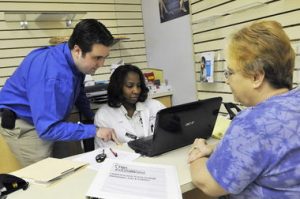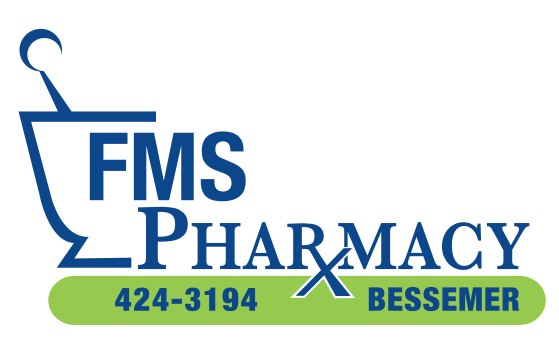FMS Pharmacy in Bessemer is a little different from your average drug store.
Behind the high counter, pharmacist Patrick Devereux greets most who enter by name, then takes the time to talk with them about health problems and medications while they wait.
 Nearby, a pharmacy resident runs a one-on-one diabetes clinic with a patient. The place is decked out with signs for other services: cholesterol checks, diabetic footwear sales and immunizations.
Nearby, a pharmacy resident runs a one-on-one diabetes clinic with a patient. The place is decked out with signs for other services: cholesterol checks, diabetic footwear sales and immunizations.
And all that is just part of what pharmacists say is their new role in public health.
“The equivalent of the entire U.S. population crosses the doors of a pharmacy every week, so there’s a potential for a health care encounter to occur even if that’s not the point of the visit,” said Michael Hogue, chairman of the department of pharmacy practice at Samford University’s McWhorter School of Pharmacy. “We need to leverage that access.”
Samford’s pharmacy school made public health a priority for its programs about a decade ago, partly because of its Christian mission, Hogue said.
PRESCRIPTIONS
Among services now being provided by some pharmacists:
• Giving shots
• Checking patients’ cholesterol
• Giving diabetes instruction
• Checking for medical errors while filling prescriptions
• Tracking medications prescribed by multiple physicians
• Teaching patients about drug usage and interactions
• Providing health screenings
• Reminding patients of lifestyle changes that can improve health
“We saw there being a great opportunity for the school to connect, to do something that would be consistent with our mission and at the same time further the basic tenets of public health,” he said.
Now Samford faculty work at the Jefferson County Department of Health, Cooper Green Mercy Hospital, Christ Health Center in Woodlawn and other locations. Students do practical rotations in community pharmacies, and the university offers what it says is the country’s first residency program in public health for post-doctoral pharmacists.
Two years ago, the school received an award from the American Association of Colleges of Pharmacy for its innovative work in communities.
Samford may be leading the way, but around the country, pharmacists are stepping into the spotlight. They are already part of the front line in a public health emergency, whether it’s giving shots and medication in a pandemic — as happened with the H1N1 flu scare — or providing emergency medications to patients cut off or displaced in a natural disaster, as happened after Hurricane Katrina.
And now they’re taking on more responsibilities.
“The pharmacist’s role is expanding beyond the traditional product-oriented functions of dispensing and distributing medicines and health supplies. …,” reads a policy statement by the American Public Health Association. “Apart from dispensing medicine, pharmacists have proven to be an accessible resource for health and medication information.”
According to the APHA, pharmacists can help catch medical errors as they fill prescriptions; track medications prescribed by multiple physicians; teach patients about drug usage and interactions; provide health screenings, prevention and education; and remind patients of lifestyle changes that can improve their health — all things that can save the health care system money.
They also provide access to care in some rural areas and inner-city neighborhoods where primary care physicians are few and far between.
“It’s just a reality that in a lot of communities, the only health care provider that’s easily accessible on a regular basis is a pharmacist,” Hogue said.
And even when patients do have a regular doctor, they may be able to take care of lab work or ask questions at a pharmacy at less cost and without feeling rushed.
Take Carlotta Crider, who came into FMS on a recent weekday for a diabetes consultation. Samford student Santonia Stanford went through her medication list with her, pointing out that she was taking more drugs for her diabetes than she realized. Stanford also printed out her glucose readings, checked her meter and went over a meal plan with her.
“I know what to do, I just don’t know how to do it,” said the 64-year-old from Bessemer.
Devereux said pharmacists don’t want to take over any of a doctor’s jobs, but believe they can be part of the continuum of care for many patients. Offering more services, in turn, brings patients into the store and helps small pharmacies like FMS stay in business, he said.
Crider said she fills most of her prescriptions at CVS, but has started coming into FMS more often for glucose test strips and other items.
“Right now, we’re still viewed as the pill dispenser; we’re not part of the care team yet,” Devereux said. “But I think we’re going to start seeing more of a primary care role for pharmacists.”

